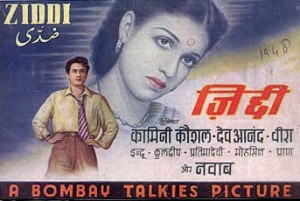The release of Alam Ara in 1931 brought a new zeal in the field on Indian cinema. The 1930’s saw Indian cinema transform with the emergence of film studios. The cinema fraternity took a clue from Hollywood in their production methods and established production houses enabling film production to be done under one roof.
B.N. Sircar’s New Theatres Ltd in Calcutta (established in 1930) and Prabhat Talkies (1929) came up in Pune.
Himanshu Rai and Devika Rani along with businessmen like F.E.Dinhsaw, Sir Firoze Sethna and others set up the Bombay Talkies in 1934 with a capital of Rs. 25 lakhs.Franz Osten and Niranjan Pal as its first full-time filmmakers. Himanshu Rai, designed and equipped the studio with sound and echo-proof stages, automatic laboratory, editing rooms, preview theater and highly skilled staff (many of German origin). Bombay Talkies produced several controversial motion pictures challenging aspects of Indian society, such as the caste social system.
It was the first movie company of India, which was a public limited company and was registered as a company under the Indian Companies Act. Soon, Bombay Talkies emerged as a well organized, self-sufficient, and profitable company, and made public issues, declared dividends and bonus, and at its heyday commanded a good standing on the Bombay Stock Exchange.
Himanshu Rai brought real talent into the company’s newcomers who justified Rai’s faith in them and becoming stars in the times to come.Ashok Kumar was one such newcomer. He worked as a laboratory assistant with New Theaters for a time in 1934. While he was planning to proceed to Germany for further training in film technique, Rai offered him a job with Bombay Talkies, in the same position that he held with New Theaters. Ashok Kumar then became one of the most sought after actors of that time. Raj Kapoor also worked as a clapper-boy for the Bombay Talkies and later went on to become another of its star products.Devika Rani Chaudury acclaimed for her beauty and sensitive performances was offered her first role in films by Rai. She later became his wife.
Soon news of the studios competence spread far and wide and Bombay Talkies became training ground for a large number of directors and technicians of the stature of N R Acharya, Najam Naqvi, R D Mathur, S Mukherji, S Vacha, M I Dharamsey.
The first film to be produced at the studio was Jawani Ki Hawa (1935) starring Devika Rani, .The studio rose to fame with Jeevan Naiya (1936), a romantic drama, which featured Devika Rani and debutant Ashok Kumar and it was followed up with Achhut Kanya.
After the outbreak of World War II in 1939, Bombay Talkies faced a number of problems, resulting in a nervous breakdown and subsequent demise of Himanshu Rai in 1940. The control of the film company passed on to his wife, Devika Rani, who was also made the controller of production of the Bombay Studios. Devika Rani continued the high tradition of Bombay Talkies. Some of the famous movies of the period included Kangan and Bandhan. Madhubala’s debut film as a child artist named Baby Mumtaz was in the movie Basant(1942).
In 1943 came Kismet , a successful thriller starring Ashok Kumar saw packed cinema houses all around.The movie created a record for run of a movie – the movie continued to run for more than three and half years in Roxy, a movie theatre of Calcutta.
Soon a rift arose between Devika Rani and her business partners, Sashadhar Mukherjee and Ashok.Eventually Sashadhar broke away to form Filmistan, resulting in the decline and eventual failure of the studio.

In 1945 Devika Rani got married and movedaway from films and production . Ashok Kumar with his brother in law Sashadhar purchased the studio after Devika Rani left it and tried to revive it, making Ziddi- Dev Anands first hit in 1948 and Mahal in 1949, but the company closed down in 1954.
Aghajani Kashmeri who wrote screenplay and dialogues story under Himanshu Rai subsequently teamed up with Sashadhar Mukherjee and worked for Filmistan.He later wrote many films for him, including Love in Simla, in which Aghajani introduced Sashadhar’s son, Joy Mukherjee in his very first role as a hero.
Today the premises of the Bombay Talkies are in a dilapidated state and many small-scale cottage industries are run in the compound. Nothing reminiscent of the great past it had!
